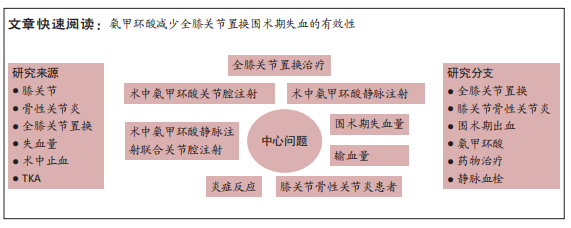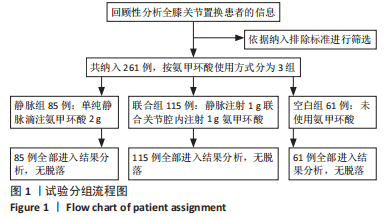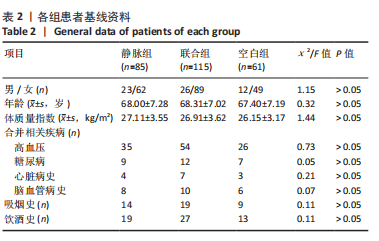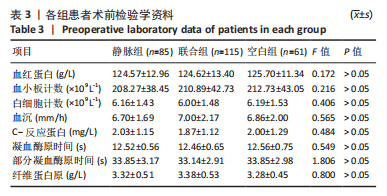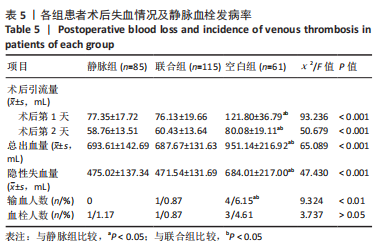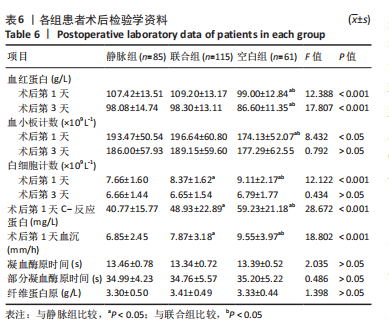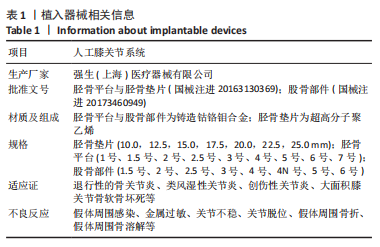全膝关节置换常见的适应证是膝关节骨性关节炎,膝关节骨性关节炎患者的增加是全膝关节置换数量增长的原因之一,全膝关节置换可通过减轻疼痛和改善功能来提高膝关节骨性关节炎患者的生活质量[16]。但全膝关节置换围术期失血量大、输血率高,同种异体输血可导致发热、过敏、溶血等多种不良反应[17],延长了患者住院时间、增加了医保负担。氨甲环酸是一种赖氨酸衍生物,通过其抗纤溶活性可达到减少失血的目的。HANREICH等[18]对不同年龄段行关节置换患者进行回顾性分析,发现缺乏氨甲环酸应用和较低的术前血红蛋白水平是增加输血率的独立因素,并建议常规应用氨甲环酸以降低80岁以上患者的输血率,这与此次研究结果相一致。氨甲环酸的应用可有效降低全膝关节置换围术期出血量,且使用氨甲环酸患者术后血红蛋白水平显著高于未使用患者
(P < 0.05),术后低血红蛋白水平可导致手术伤口愈合障碍,假体周围感染[19]。术后血红蛋白的变化是围术期输血的重要因素,且围术期输血患者的并发症发病率高[20]。
目前氨甲环酸被广泛应用于全膝关节置换,其有效性、安全性已得到了大量验证[21-22],但对于全膝关节置换联合使用氨甲环酸的最佳给药剂量和用法尚无统一标准。氨甲环酸的作用与其在血浆中的浓度相关:10-15 mg/L的质量浓度会显著抑制纤维蛋白溶解,5-10 mg/L的质量浓度会部分抑制纤维蛋白溶解[23]。当前全膝关节置换使用氨甲环酸的常见途径为静脉注射与关节腔内注射。静脉注射药物作用于患者全身,患者血浆药物浓度高,通过扩散到滑液和滑膜中,到达关节液中的药物半衰期约为3 h[24]。氨甲环酸静脉注射需要5-15 min达到有效药物浓度,而肌肉注射需要30 min,因此,接受全膝关节置换患者首选静脉注射途径,以最快地达到和维持氨甲环酸的治疗浓度;关节腔内注射给药,患者局部药物浓度高,给药1 h的生物利用度为81%,给药后8 h的血药浓度高于治疗性血药浓度[25]。局部使用氨甲环酸的优势在于在伤口闭合时直接作用于出血部位,形成纤维斑块,减少手术伤口出血,但局部注射氨甲环酸给药的接触时间不足,无法充分浸入使用引流管的膝关节前部组织,同时全膝关节置换期间需要松解软组织以平衡膝关节张力,这可能导致氨甲环酸溶液溢出关节,且有研究报道,局部使用氨甲环酸可对肌腱愈合产生不利影响和细胞毒性等不良反应[26]。XIONG等[27]对全膝关节置换中静脉和局部氨甲环酸联合给药的疗效和安全性进行荟萃分析,共纳入6项随机对照试验,涉及701例患者,结果表明:单纯局部使用氨甲环酸或单纯静脉注射与联合静脉、关节腔内注射使用相比,联合组总出血量较低。与之相同的,ABDALLA等[28]对全膝关节置换术中局部氨甲环酸使用的安全性及有效性进行分析,该研究共纳入94例行全膝关节置换患者,分为3组:单纯关节组、单纯静脉组与联合组,单纯静脉组与联合组在止血带放气前
10 min静脉注射2 g氨甲环酸,单纯关节组与联合组在膝关节周围应用1.5 g氨甲环酸,分析3组患者术后引流血量、总失血量、隐性失血量、术中失血量及同种异体输血率等相关数据,结果表明,氨甲环酸的静脉与关节腔内联合给药在术后引流量、总失血量和隐性失血方面表现出更好的结果。但CHALMERS等[29]对全膝关节置换患者进行回顾性分析,该研究共纳入6 159例2次静脉注射氨甲环酸患者与561例单次静脉注射联合局部使用氨甲环酸患者,比较使用2剂静脉氨甲环酸与1剂的局部联合静脉氨甲环酸的组合在患者总失血量、输血率及术后相关并发症等相关数据,以评估这种组合是否存在协同效应,结果表明,双倍剂量静脉注射氨甲环酸和联合单次静脉注射与局部使用氨甲环酸剂量在减少初次全膝关节置换失血量与输血率方面同样有效,并不具有协同效应。JULES-ELYSEE等[30]通过一项随机对照研究发现,局部使用氨甲环酸与静脉注射使用氨甲环酸均可有效降低围术期出血量,且二者的总失血量差异无统计学意义。此次研究结果发现,使用氨甲环酸患者在术后引流量、隐性失血量与总失血量方面均少于未使用患者;对于患者术后检验学检查结果,静脉组与联合组术后血红蛋白水平、血小板计数显著高于空白组,但静脉组患者与联合组患者术后总失血量、隐性失血量、血红蛋白水平、血小板计数均未见显著差异。作者认为:静脉注射氨甲环酸较短时间就可以到达药物治疗浓度,虽然肌肉注射达到药物治疗浓度时间长,但关节腔内注射药物直接作用于创伤表面,局部有效浓度高于血浆有效浓度,能更好地防止创面出血,因此,无论经静脉注射还是关节腔内注射,氨甲环酸药物浓度均处于有效药物浓度。由此可得,无论单纯静脉使用或联合局部使用氨甲环酸,均可有效减少全膝关节置换围术期失血量,静脉注射与关节腔内注射均为有效使用途径,二者不具有相互促进作用。
对于氨甲环酸剂量的选择,KIM等[31]对全膝关节置换中最佳局部氨甲环酸剂量进行前瞻性、随机对照研究,该研究共纳入325例计划接受全膝关节置换的患者,依据局部氨甲环酸注射剂量进行随机分组,共5组(每组n=65):对照组不使用氨甲环酸;第1组局部注射0.5 g氨甲环酸;第2组局部注射1 g氨甲环酸;第3组局部注射2 g氨甲环酸;第4组局部注射3.0 g氨甲环酸,结果表明:局部应用1 g或更多氨甲环酸可有效控制出血,但没有剂量反应关系。国内专家共识中指出[32]:单纯静脉多次给药剂量推荐1 g,联合局部与静脉可选择1 g静脉联合1 g局部注射。此次研究中静脉组使用2次静脉注射,每次1 g,联合组使用1 g静脉联合1 g局部注射,研究结果提示两者均可有效减少围术期失血量。
静脉血栓是围术期死亡的主要原因之一,随着全球人口预期寿命的延长,其患病风险持续增长,且全膝关节置换可导致静脉血栓发病率显著增加[33]。全膝关节置换围术期静脉血栓的发生将导致患者住院时间的延长,增加医疗保险负
担[34]。氨甲环酸抗纤维蛋白溶解,从理论上来说易增加全膝关节置换患者静脉血栓的发生率,但多项研究表明氨甲环酸并不增加静脉血栓发病率。POERAN等[35]对高危患者关节置换联合使用氨甲环酸进行安全性分析,共纳入765 011例患者,结果发现氨甲环酸可有效降低围术期失血量,且不增加并发症发病率。GOLZ等[36]对关节置换患者围术期使用1次或2次静脉注射氨甲环酸的安全性进行回顾性分析,该研究患者依据氨甲环酸静脉使用次数进行分组,一组患者仅在切开皮肤之前使用1 g氨甲环酸,另一组患者在切开皮肤之前与伤口闭合时各静脉使用1 g氨甲环酸,通过比较患者术后血红蛋白值、住院时间、输血率和术后并发症发病率发现,单次静脉使用氨甲环酸与2次静脉使用氨甲环酸一样有效,而不会增加术后并发症。LI等[37]对氨甲环酸在全膝关节置换中静脉注射与关节腔内注射的安全性及有效性进行分析,发现静脉注射氨甲环酸与关节腔内注射氨甲环酸并不增加静脉血栓发病率。此次研究通过监测患者围术期凝血功能变化,对患者随访至术后1个月,依据患者临床表现及影像学资料对静脉血栓发病率进行统计,结果显示共出现静脉血栓患者5例,通过统计分析3组患者静脉血栓发病率无统计学意义
(P > 0.05)。下肢静脉血栓是由于血液在下肢深静脉管腔内的异常凝血,阻塞下肢深静脉,引起下肢深静脉血流障碍。理论上,氨甲环酸属于抗纤溶药物,可导致全膝关节置换后静脉血栓发病率增加,但全膝关节置换导致膝关节周围纤溶活性增强,诱发术后出血,氨甲环酸通过纤溶酶和纤溶酶原上赖氨酸结合部位吸附,抑制了纤溶系统、减少出血。而且,关节腔内氨甲环酸药物半衰期为3 h,半衰期时间短,对人体凝血功能影响小,术后患者凝血酶原时间、部分凝血酶原时间、纤维蛋白原水平进行监测,显示凝血功能均在正常范围内。因此,单纯静脉注射或联合局部使用氨甲环酸可有效降低总出血量,且不会增加静脉血栓的发生率。
氨甲环酸除了可以抑制纤溶系统,还具有抗变态反应与消炎作用,其抗变态反应与消炎作用与纤溶酶有关:纤溶酶可促进炎症细胞活化和炎症递质基因表达,进而诱发炎症级联反应[38]。XIE等[39]对151例患者进行随机对照研究,对行全膝关节置换患者多次静脉注射氨甲环酸进行分析,研究结果表明,多次静脉注射氨甲环酸可更好地降低术后炎症反应、减轻患者术后疼痛。全膝关节置换后疼痛与炎症反应密切相关,预防和控制术后疼痛至关重要,不仅可以避免不必要的痛苦,而且可以减少术后并发症发病率、恢复时间、住院时间和相关费用。此次研究表明,静脉组与联合组术后失血量差异无统计学差异,但通过患者术后白细胞计数、C-反应蛋白及血沉发现静脉组术后炎症反应轻。虽然局部注射氨甲环酸在局部可获得更高的药物浓度,但静脉注射氨甲环酸血浆药物达到有效浓度时间短,且血浆药物浓度高。全膝关节置换后患者炎症反应不仅来源于手术创面的影响,更是身体对损伤的反应,静脉注射氨甲环酸后,较高的血浆药物浓度能更好地应对全身炎症反应。因此,全膝关节置换术后无论单纯静脉注射使用氨甲环酸或静脉联合关节腔内注射氨甲环酸,均可有效降低患者术后炎症反应,使用氨甲环酸患者术后白细胞计数、C-反应蛋白水平及血沉均低于未使用患者,值得一提的是,单纯静脉注射2 g氨甲环酸可更有效减轻术后炎症反应。
研究存在几个不足之处:第一,样本数目少,仅纳入行全膝关节置换患者信息,需要更大样本量来进一步证实氨甲环酸在全膝关节置换应用的安全性及有效性;第二,研究没有进一步分析不同途径给药的血浆药物浓度与时间关系。
综上所述,此次研究通过对261例全膝关节置换患者资料进行回顾性分析,进一步分析全膝关节置换围术期使用氨甲环酸的有效性及安全性,结果表明,单纯静脉注射或联合使用氨甲环酸均可有效降低全膝关节置换围术期失血量、减少血红蛋白丢失少、降低输血率,且氨甲环酸可有效减轻围术期炎症反应。虽然氨甲环酸属于抗纤溶系统药物,但研究表明,使用氨甲环酸并不会额外增加全膝关节置换患者静脉血栓的发病率。
中国组织工程研究杂志出版内容重点:人工关节;骨植入物;脊柱;骨折;内固定;数字化骨科;组织工程
